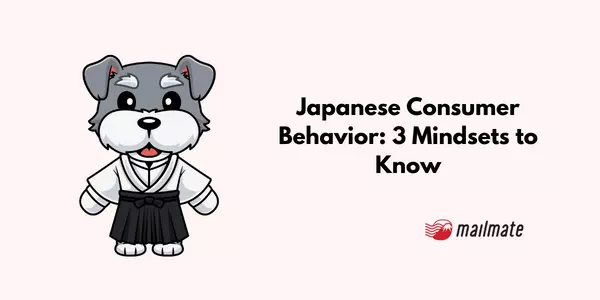Japanese Consumer Behavior: 3 Mindsets to Know

What are the mindsets influencing consumer behavior in Japan that everyone ought to know about? When Japanese consumers encounter your product or service, what goes through their minds?
We know one thing for sure: Japanese households' financial assets hit a record high of 1,901 trillion yen in 2020. And Japan has held top spots on global savings lists for many years.
If there's a key to the Japanese market and unlocking Japan's penny-pinching tendencies, what is it?
Today, we discuss mindsets that—to some extent or another—play a role in influencing Japanese consumers' buying behavior, which you should understand before crafting your next marketing campaign.
Mindset 1: Saving is a necessity
Every country has a percentage of savers and a percentage of spenders. In Japan, the savers win by a wide margin.
A poll conducted by BIGLOBE revealed over 80.3% of the 1,000 respondents chose "saving-oriented" and "relatively saving-oriented" as their response when asked how they spent their money.
Some might consider this data point on Japanese consumer behaviour a natural reflex from Japanese shoppers over the recent pandemic—yet Japan's saving ways go back further than this.

Thirty decades of negative to low inflation and the bubble collapse in 1990 have led to a Japanese culture of saving to offset dwindling prospects. With a rapidly aging demographic and concerns of declining social security benefits, Japanese consumers feel anxious and have responded by saving more.
Magazines, YouTube channels, and countless books on the topic have cropped up in response to demand for content on "the art of saving" (setsuyaku jutsu).
Popular YouTubers open their housekeeping books (kakeibou), displaying how little they can get by on, revealing item-by-item prices, often proudly and sometimes competitively, and discussing which discount and online retailers are best for online shopping.
As a business owner targeting Japanese consumers, learning how to use the concept of money-saving in your marketing is one key to making your product attractive to Japan's consumers.
Mindset 2: Respect for material possessions
In the book The Life-Changing Magic of Tidying Up, Marie Kondo says, "One of the homework assignments I give my clients is to appreciate their belongings. For example, I urge them to try saying, 'Thank you for keeping me warm all day,' when they hang up their clothes after returning home. … Express your appreciation to every item that supported you during the day."
Do other Japanese individuals talk to their clothes? I've personally heard of none who do this. But Ms. Kondo hits on a notion that many Japanese are instilled with: Respect for material possessions.

Shintoism influences consumer trends by moderating how Japanese consumers treat and regard their possessions; it teaches that in everything dwells a god, and it could be the source of why Japanese consumers believe in reverencing possessions.
Another possibility can be found in the Japanese phrase "mottainai," loosely equivalent to the English idiom, "waste not, want not."
Mottainai is used to express why a Japanese person will hold on to an object, even if it appears to be outdated. Or why an individual will refuse to purchase a new product when they have something at home they can use for a similar purpose.
Instead, Japanese companies focus on emphasizing seasonal events and national holidays in their marketing campaigns because Japanese are often more willing to spend on an item meant to help mark an occasion or event rather than purchasing a new item because the last item they bought was ill-cared for (which is rarely the case).
For instance, students enter a new school or begin a new school year in April, and you'll typically see plenty of campaigns themed on "new life support campaign" (shin seikatsu ouen campaign) around this time, giving grandparents and parents a legitimate reason to splurge on their offspring in a way that won't conflict with their saving or mottainai mindsets.
And when it comes time to mark special occassions, Japanese consumers will shun cheaper products.
But there is another occasion where Japanese will feel compelled to purchase…
Mindset 3: The bandwagon effect
Most Japanese will try a new product out if they believe an item is "popular" = enough other people are trying out the new thing.
This point is particularly worth noting for international brands and foreign companies looking to find a new Japanese consumer group.
Long lines in front of ramen shops, restaurants, and other places, have become an established indicator of whether or not a place is worth a visit. When long lines form in front of a store, this indicates a sense of security to the risk-averse Japanese consumer. Ultimately, the higher the sense of security, the higher the degree of purchase.
Japanese ad companies use the bandwagon effect in a variety of ways. For theatrical releases to the domestic market, distributors will often wait until after Hollywood's awards season to use factors such as how popular a movie was in other countries (awards won, viewing statistics, and associated coverage) to boost interest in Japan.
Additionally, for large market segments in Japan, TV CMs play a sizeable role in convincing consumer-hesitant Japanese that a product is enjoying outstanding popularity. Simply referencing that a product was on television lends a measure of credibility to the product (go to a store and you'll see signs that say “as seen on TV CM”), as the chances are high that friends or coworkers have seen the same CM.
The use of Japanese celebrities is another way in which the bandwagon effect plays out. A celebrity lends his or her considerable following to a product, making it safe to try whatever the celeb is advertising.
In recent years, companies in Japan use online forums and online communities to get closer to customers who are interested in the company's products. Creating an online community can foster the feeling of popularity and also provide companies with a direct line to customers and interested parties.
Frequently asked questions
What characterizes Japanese consumer behavior?
Some key components of Japanese consumer behavior include their desire to save, respect for material possessions, and their desire to have what everyone else considers popular or en vogue.
How does culture influence consumer behavior in Japan?
Concepts such as "the art of saving" (setsuyaku jutsu)" and the desire to not be wasteful, "mottainai," play significant roles in shaping consumer preferences.
Are Japanese consumers brand conscious?
Individuals who became adults during Japan's bubble era—a time when Japan was flourishing economically—are more brand conscious than other Japan's younger generations. But brand consciousness still remains strong across all generation segments.
What role does sustainability play in Japanese consumer behavior?
The Japanese phrase "mottainai," loosely equivalent to the English idiom, "waste not, want not" ties in to Japan's recent trend toward sustainability. Mottainai is used to express why a Japanese person will hold on to an object, even if it appears to be outdated. Or why an individual will refuse to purchase a new product when they have something at home they can use for a similar purpose.
In closing
Japanese consumers' desire to save, reverence of things, and risk-averse nature are essential to consider if businesses want their marketing pitch to appeal to the Japanese consumer.
Yet, the 3 mindsets discussed here are far from the only cultural factors influencing the market segment you wish to target.
For instance, there are regional differences between spending patterns (e.g., Tokyo vs. Osaka), differences based on income level, household makeup, and career and education sectors. Additionally, with emerging platforms comes new audiences to track and target.
The more you can find out about your market's individual preferences, the more you will speak to the current issues your customers face.
Spending too long figuring out your Japanese mail?
Virtual mail + translation services start at 3800 per month. 30-day money-back guarantee.

